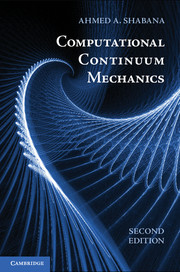Book contents
- Frontmatter
- Contents
- Preface
- 1 Introduction
- 2 Kinematics
- 3 Forces and Stresses
- 4 Constitutive Equations
- 5 Plasticity Formulations
- 6 Finite Element Formulation: Large-Deformation, Large-Rotation Problem
- 7 Finite Element Formulation: Small-Deformation, Large-Rotation Problem
- 8 Computational Geometry and Finite Element Analysis
- References
- Index
1 - Introduction
Published online by Cambridge University Press: 05 June 2012
- Frontmatter
- Contents
- Preface
- 1 Introduction
- 2 Kinematics
- 3 Forces and Stresses
- 4 Constitutive Equations
- 5 Plasticity Formulations
- 6 Finite Element Formulation: Large-Deformation, Large-Rotation Problem
- 7 Finite Element Formulation: Small-Deformation, Large-Rotation Problem
- 8 Computational Geometry and Finite Element Analysis
- References
- Index
Summary
Matrix, vector, and tensor algebras are often used in the theory of continuum mechanics in order to have a simpler and more tractable presentation of the subject. In this chapter, the mathematical preliminaries required to understand the matrix, vector, and tensor operations used repeatedly in this book are presented. Principles of mechanics and approximation methods that represent the basis for the formulation of the kinematic and dynamic equations developed in this book are also reviewed in this chapter. In the first two sections of this chapter, matrix and vector notations are introduced and some of their important identities are presented. Some of the vector and matrix results are presented without proofs because it is assumed that the reader has some familiarity with matrix and vector notations. In Section 3, the summation convention, which is widely used in continuum mechanics texts, is introduced. This introduction is made despite the fact that the summation convention is rarely used in this book. Tensor notations, on the other hand, are frequently used in this book and, for this reason, tensors are discussed in Section 4. In Section 5, the polar decomposition theorem, which is fundamental in continuum mechanics, is presented. This theorem states that any nonsingular square matrix can be decomposed as the product of an orthogonal matrix and a symmetric matrix. Other matrix decompositions that are used in computational mechanics are also discussed. In Section 6, D’Alembert’s principle is introduced, while Section 7 discusses the virtual work principle. The finite element method is often used to obtain finite dimensional models of continuous systems that in reality have infinite number of degrees of freedom. To introduce the reader to some of the basic concepts used to obtain finite dimensional models, discussions of approximation methods are included in Section 8. The procedure for developing the discrete equations of motion is outlined in Section 9, while the principle of conservation of momentum and the principle of work and energy are discussed in Section 10. In continuum mechanics, the gradients of the position vectors can be determined by differentiation with respect to different parameters. The change of parameters can lead to the definitions of strain components in different directions. This change of parameters, however, does not change the coordinate system in which the gradient vectors are defined. The effect of the change of parameters on the definitions of the gradients is discussed in Section 11.
- Type
- Chapter
- Information
- Computational Continuum Mechanics , pp. 1 - 45Publisher: Cambridge University PressPrint publication year: 2011

